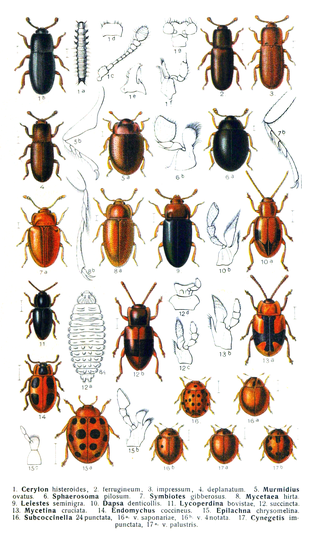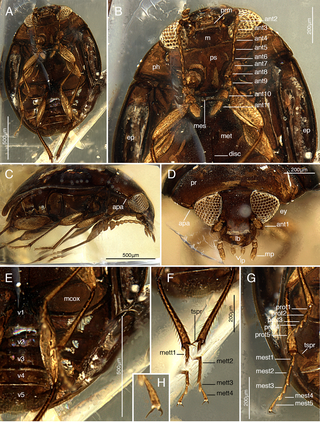
Myxophaga is the second-smallest suborder of the Coleoptera after Archostemata, consisting of roughly 65 species of small to minute beetles in four families. The members of this suborder are aquatic and semiaquatic, and feed on algae.

Cucujoidea is a superfamily of beetles. This group formerly included all of the families now included in the superfamily Coccinelloidea. They include some fungus beetles and a diversity of lineages of "bark beetles" unrelated to the "true" bark beetles (Scolytinae), which are weevils.

Scirtoidea is a superfamily of beetles. It is traditionally considered to consist of four families: Clambidae, Decliniidae, Eucinetidae and Scirtidae. However, genetic studies have suggested that Clambidae and Eucinetidae belong to a separate superfamily Clamboidea, which also includes Derodontidae. Scirtoidea and Clamboidea are the two earliest diverging lineages of living polyphagans.

Jacobsoniidae are a family of tiny beetles belonging to Staphylinoidea. The larvae and adults live under bark, in plant litter, fungi, bat guano and rotten wood. There are around 28 described species in three genera:

Nosodendridae is a family of beetles, with only 67 species in three extant genera, which are found worldwide. Nosodendron, the largest genus, is found in forests and attracted to yeast generated slime on the wounds of trees, and likely consumes fermented substances as well as fungi and microorganisms. Several additional genera and species are known from the fossil record. Nosodendridae is considered to be an isolated lineage within Polyphaga, being the sister group to the clade containing Staphyliniformia, Bostrichoidea and Cucujiformia.

Chaetosomatidae is a small family of beetles, in the superfamily Cleroidea. There are three extant genera, two of which are endemic to New Zealand with the other (Malgassochaetus) native to Madagascar. Members of this family are predaceous on wood-boring insects.

Trogossitidae, also known as bark-gnawing beetles, are a small family in the superfamily Cleroidea. Many taxa formerly within this family have been removed to other families, such as Lophocateridae, Peltidae, Protopeltidae, Rentoniidae, and Thymalidae. Members of the family are generally predatory and/or feed on fungi, both in adult and larval stages, and are generally associated with wood, being found under bark or inside bored tunnel galleries. There are about 400 species in 25 genera in the family under the new, restricted circumscription, as opposed to 600 species in over 50 genera in the old definition. The oldest fossil assignable to the modern, more restricted definition of the family is Microtrogossita from the mid-Cretaceous Burmese amber of Myanmar, which has close affinities to the Trogossitini, indicating that the family had already considerably diversified by this time.

Silvanidae, "silvan flat bark beetles", is a family of beetles in the superfamily Cucujoidea, consisting of 68 described genera and about 500 described species. The family is represented on all continents except Antarctica, and is most diverse at both the generic and species levels in the Old World tropics.

Helotidae is a family of beetles, in the suborder Polyphaga. The family includes about five extant genera, Helota MacLeay, Neohelota Ohta, Afrohelotina Kirejtshuk, Metahelotella Kirejtshuk, and Strophohelota Kirejtshuk. Helotidae are found mainly in the Old World tropics and are absent from Australia and Madagascar. The antennae are clubbed on the final three segments and is retractable within grooves under the head. The wings have reduced venation with just 4 anal veins. Helotids are known to be associated with sap, fruit and flowers, and the larvae of some species are known to bore into wood in order to pupate.

Smicripidae is a family of beetles, in the superfamily Cucujoidea. The common name for this family is palmetto beetles. The family only has one extant genus, Smicrips, with six extant species native to tropical and subtropical regions of the Americas and extinct species from the Eocene of Europe and one extinct genus, Mesosmicrips, known from the mid Cretaceous aged Burmese amber. Smicrips larvae are usually found amongst decaying vegetation, while adults are typically found on infloresences, especially those of Arecaceae (palms), although associations with flowers of Fabaceae (legumes), Passifloraceae, Bombacaceae and Cactaceae (cactus) have also been recorded. Their diet is unknown.

Clambidae is a family of beetles. They are known commonly as the minute beetles or the fringe-winged beetles. They are found worldwide on every continent except Antarctica.

Agapytho is the only genus of beetles in the family Agapythidae. The genus contains a single species, Agapytho foveicollis, which is endemic to New Zealand. Larvae and adults are found on sooty mold growing on Nothofagus trees. Gut contents indicate that at least adult Agapytho consume the sooty mould as part of their diet.

Cyclaxyridae are a family of beetles in the superfamily Cucujoidea. The only living genus is Cyclaxyra, with two species endemic to New Zealand. Other species have been named from fossils. They are also known as sooty mould beetles due to the association of Cyclaxyra with sooty mould. The extant species are mycophagous, feeding on spores, conidia, and hyphae.
Cyclaxyra jelineki is a species of cucujoid beetle in the family Cyclaxyridae. It is endemic to New Zealand, found on the North Island, South Island, and Stewart Island.

Metaxina is the only genus in the beetle family Metaxinidae. Its only species is Metaxina ornata. It endemic to the South island of New Zealand, where it is associated with sooty mold growing on Nothofagus trees. Both the larvae and adults are likely predaceous, feeding on insects and other arthropods. It is considered to be a member of the superfamily Cleroidea. Genetic studies have suggested that Metaxina should be considered a member of Chaetosomatidae, rather than constituting its own family.

Cyclaxyra politula is a species of cucujoid beetle in the family Cyclaxyridae. It is endemic to New Zealand, found on the North Island, South Island, and Stewart Island.

Peltis is a genus of beetles found in North America and Europe, and the sole extant member of the family Peltidae, formerly included in the Trogossitidae. Members of this genus are dark, averaging from brown, to dark brown, to black. They are small, wide, and flat-bodied with wide, ridged elytra. Fossil species of this genus are known from the Eocene aged Florissant Formation of the United States, as well as the Baltic amber of Europe.
2019 in paleoentomology is a list of new fossil insect taxa that were described during the year 2019, as well as other significant discoveries and events related to paleoentomology that were scheduled to occur during the year.
Burmese amber is fossil resin dating to the early Late Cretaceous Cenomanian age recovered from deposits in the Hukawng Valley of northern Myanmar. It is known for being one of the most diverse Cretaceous age amber paleobiotas, containing rich arthropod fossils, along with uncommon vertebrate fossils and even rare marine inclusions. A mostly complete list of all taxa described up until 2018 can be found in Ross 2018; its supplement Ross 2019b covers most of 2019.

Alloterocucus is an extinct genus of beetle. It is known from a single species, Alloterocucus atratus, known from the mid Cretaceous Burmese amber of Myanmar. It belongs to the clade Cucujiformia, probably Cucujoidea, and is not assigned to any family. Cladistic analysis suggests that it is closely related to Cyclaxyridae, Tasmosalpingidae, and Lamingtoniidae, and is possibly most closely related to Lamingtoniidae.

















